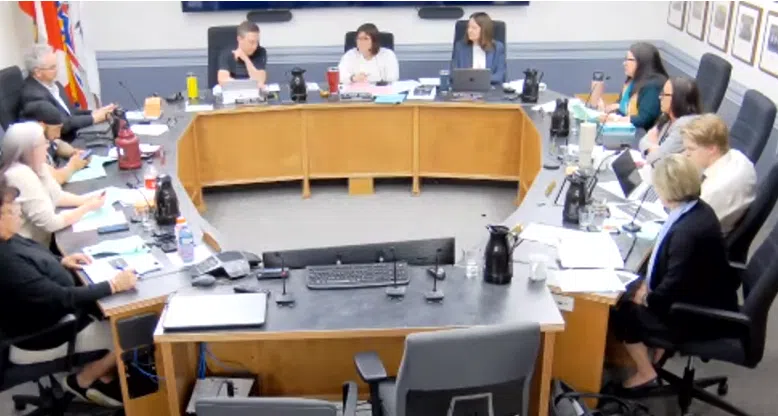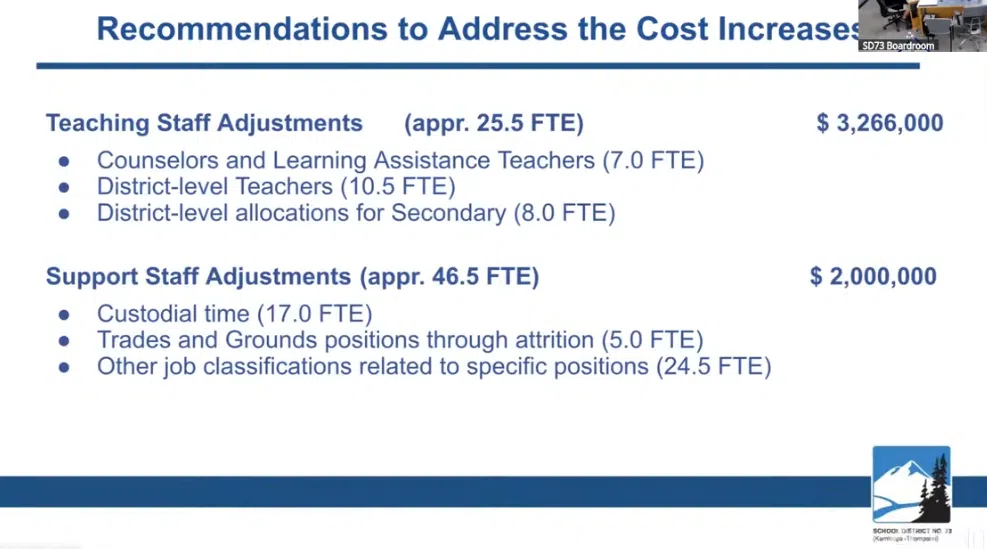
The Kamloops-Thompson School Board is moving forward with its 2025/2026 budget which includes a reduction of 25.5 full time equivalent (FTE) teaching positions along with 46.5 FTE support staff positions.
Superintendent Rhonda Nixon says the changes will primarily affecting district-level teachers and secondary school allocations. Nixon explains what an FTE is. “It can be blocks of time, not people. It is not like we’re going to cut 25 positions. Rather, we’re cutting 25.5 FTE, or full time equivalent in terms of the time. So we have reduced counselors and Learning Assistance Resource teachers by 7.0 FTE. So we take blocks of time from across our schools, and yes, it reduces that time, and that is not something we wish to do, but I just want to be clear that it doesn’t necessarily mean we lose seven people. I think that’s important.”
“So what’s happening now is, the reason we proceed through HR is it has to be handled very ethically, confidentially with individuals. So individual letters have been created. We met with the principals this morning. Let them know if you have staff impacted.”
“We normally give schools and a certain amount of money for each international student. When we give them that money, they buy blocks of time. And what we did is keep back almost half that money so they get, you know, less money per student, so they can buy fewer blocks. That’s an example of a reduction.”

“We used to give blocks of time to Leadership Development Program candidates. So people who are going into and selected to go into a leadership development program would get a certain number of blocks of time. Those blocks were taken back and put into classroom blocks. So we’ve discontinued funding for Sports teams. We used to give time for teachers to take teams to tournaments, that $100,000 worth of time we’ve taken back and put in the budget.”
“So I want to be clear. I’m not saying it’s not impactful, it is. And it all matters. But it’s not just as simple as we’ve taken away people sometimes we’ve taken away money that would have been giving people time.”
In temrs of support staff, Nixon notes that janitorial work has been cut by 17 FTEs. “Okay, so our building was selected, and unfortunately, then this position attached to this building is selected, and then HR works with each individual and looks at all their qualifications and different opportunities for them. So it is a real wraparound process. It is a team approach, and it is really important that you understand we’re not just sending letters out to people to inform them.”
The budget also includes a reduction in Trades and Grounds positions, which is being done through attrition and the rest is being made up in various other ways.
Funding not Changing
The decisions are being made as a result of a budget shortfall of a more than $5 million dollars. Board Chair Heather Grieve says that has come as a result of expected enrollment increases not coming to fruition and the province has made no changes to the way in which districts are funded. “If you look at the per student funding being $9,000 per student, that was about $2,225,000 that we were receiving in increased revenue each year with with the enrollment increases, and we actually have seen enrollment flatten and potentially dip a little bit in terms of the number of students we have.”
Grieve says the board will continue to advocate for changes to the funding model which is something that is impacting every district in BC. “We need to talk to our our MLAs, our mayor and council provincially, within our organization, and continue to talk to the Minister of Education and message around how we’re being impacted by the current funding structure.”
“That was talked about at the BC school trustee association that nationally British Columbia is second lowest in terms of funding for education. And so again, we just need to continue to have those conversations. So obviously, if things changed and we saw increase in per student funding or an increase in ways that we’re able to alleviate some of these cost pressures, then we would obviously be able to take a look at the budget and take recommendations from staff around how we wanted to implement those dollars.”















